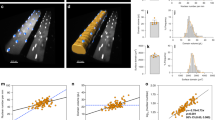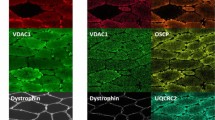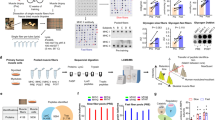Abstract
MOST muscles are composed of a mixture of two types of muscle fibre which can be shown to differ in myoglobin content. Slow type 1 fibres are narrow, contain numerous mitochondria and are poor in glycogen and phosphorylase. Fast type 11 fibres are broad, contain few mitochondria and are rich in glycogen and phosphorylase1. It has been assumed that type 1 fibres are rich in myoglobin and these are termed red. Type 11 fibres are assumed to be poor in myoglobin and are termed white. Similarly, it has been assumed that the large nuclear bag fibres of muscle spindles are poor in myoglobin and that they contract rapidly. The smaller nuclear chain fibres would be expected to be rich in myoglobin and contract slowly. No comprehensive survey of the myoglobin content of muscle fibres has previously been reported. Knowledge of the precise distribution of myoglobin in extrafusal and intrafusal fibres would throw light on the function of myoglobin and muscle spindle activity.
This is a preview of subscription content, access via your institution
Access options
Subscribe to this journal
Receive 51 print issues and online access
$199.00 per year
only $3.90 per issue
Buy this article
- Purchase on Springer Link
- Instant access to full article PDF
Prices may be subject to local taxes which are calculated during checkout
Similar content being viewed by others
References
Dubowitz, V., and Pearse, A. G. E., Histochemie, 2, 105 (1960).
Yellin, H., and Guth, L., Fed. Proc., 26, 554 (1967).
Ogata, T., and Mori, M., J. Histochem. Cytochem., 12, 171 (1964).
Barker, D., and Hunt, J. P., Nature, 203, 1193 (1964).
Goldfischer, S., J. Cell. Biol., 34, 398 (1967).
Chinoy, N. J., J. Anim. Morphol. Physiol., 10, 74 (1963).
Chinoy, N. J., and George, J. C., Pavo, 2, 12 (1964).
Drews, G. A., and Engel, W. K., J. Histochem. Cytochem., 9, 206 (1961).
Nene, R. V., and George, J. C., Pavo, 3, 35 (1965).
Chandra-Bose, D. A., Chinoy, N. J., and George, J. C., Pavo, 2, 61 (1964).
Wirsen, C., J. Histochem. Cytochem., 12, 308 (1964).
Wachstein, M., and Meisel, E., J. Histochem. Cytoehem., 12, 22 (1964).
Wachstein, M., and Meisel, E., J. Histochem. Cytochem., 12, 538 (1964).
Sabatini, D. D., Bensch, K., and Barnett, R. J., J. Cell. Biol., 17, 19 (1963).
Kagen, L. J., and Gurevitch, R., J. Histochem. Cytochem., 15, 436 (1967).
Hemmingsen, E. A., and Scholander, P. F., Science, 132, 1379 (1960).
Hemmingsen, E. A., Comp. Biochem. Physiol., 10, 239 (1963).
Wittenberg, J. B., Biol. Bull., 117, 402 (1959).
Boyd, I. A., J. Physiol., 187, 10P (1966).
Smith, R. S., Muscular Afferents and Motor Control (First Nobel Symposium, June 1965).
Author information
Authors and Affiliations
Rights and permissions
About this article
Cite this article
JAMES, N. Histochemical Demonstration of Myoglobin in Skeletal Muscle Fibres and Muscle Spindles. Nature 219, 1174–1175 (1968). https://doi.org/10.1038/2191174a0
Received:
Revised:
Issue Date:
DOI: https://doi.org/10.1038/2191174a0
This article is cited by
-
Glycolysis activity in flight muscles of birds according to their physiological function. An experimental model in vitro to study aerobic and anaerobic glycolysis activity separately
Molecular and Cellular Biochemistry (2009)
-
Diffusion of myoglobin in skeletal muscle cells ? dependence on fibre type, contraction and temperature
Pfl�gers Archiv European Journal of Physiology (1995)
-
Relationship between myoglobin and succinate dehydrogenase in mouse soleus and plantaris muscle fibres
The Histochemical Journal (1985)
-
Fibre-optic spectrophotometry of immature bovine skeletal muscles and the cellular distribution of myoglobin and succinate dehydrogenase
The Histochemical Journal (1985)
-
Histochemical study of normal human muscle spindle
Journal of Neurology (1977)
Comments
By submitting a comment you agree to abide by our Terms and Community Guidelines. If you find something abusive or that does not comply with our terms or guidelines please flag it as inappropriate.



